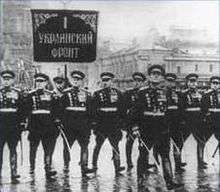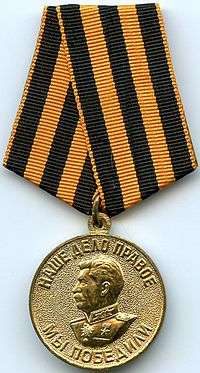Moscow Victory Parade of 1945
The Moscow Victory Parade of 1945 (Russian: Парад Победы, tr. Parad Pobedy) was a victory parade held by the Soviet Armed Forces (with the Color Guard Company representing the First Polish Army) after the defeat of Nazi Germany. This, the longest and largest military parade ever held on Red Square in the Soviet capital Moscow, involved 40,000 Red Army soldiers and 1,850 military vehicles and other military hardware. The parade lasted just over two hours on a rainy June 24, 1945, over a month after May 9, the day of Germany's surrender to Soviet commanders.
Stalin's order for the observance of the parade
The parade itself was ordered by Joseph Stalin on June 22, 1945, by virtue of Order 370 of the Office of the Supreme Commander in Chief, Armed Forces of the USSR. This order is as follows:
| “ |
Order of the Supreme Commander in Chief, Armed Forces of the USSR and concurrent People's Commissar of State for National Defense To mark the victory over Germany in the Great Patriotic War, I order a parade of troops of the Army, Navy and the Moscow Garrison, the Victory Parade, on June 24, 1945, at Moscow's Red Square. Marching on parade shall be the combined regiments of all the fronts, a People's Commissariat of National Defense combined regiment, the Soviet Navy, military academies and schools, and troops of the Moscow Garrison and Military District. My deputy, Marshal of the Soviet Union Georgy Zhukov will be the parade inspector. Marshal Konstantin Rokossovsky will command the Victory Parade itself. I entrust to Col. Gen. Pavel Artemyev, the preparations and the supervision of the parade organization, due to his concurrent capacities as the Commanding General of the Moscow Military District and Commanding Officer in charge of the Moscow City Garrison.
|
” |
This was preceded by another letter by General of the Army Aleksei Antonov, Chief of the General Staff of the Soviet Armed Forces to all the participant fronts in attendance on the 24th of the previous month which is as follows:
| “ |
Order to the Fronts who will participate in the Victory Parade The Supreme Commander-in-Chief of the Armed Forces has ordered that: 1. In order for the front to participate in the Moscow City parade in honor of the victory over Germany, each front will be represented by a combined regiment which is to be raised among them.
All in all the regiment will be composed of 1,059 male active personnel and 10 additional reserve personnel.
4. The companies in attendance will be manned so as to have the middle-ranked officers commanding the squads, which are then composed of privates and sergeants.
6. The Front Commanders and all commanders including air and tank army commanders will arrive in Moscow for the Parade.
|
” |
Marshals Georgy Zhukov, who had formally accepted the German surrender to the Soviet Union, and Konstantin Rokossovsky, rode through the parade ground on white and black stallions, respectively.[1] The fact is commemorated by the equestrian statue of Zhukov in front of the State Historical Museum, on Manege Square. Zhukov's stallion was called Кумир ("Idol"). The General Secretary of the Communist Party of the Soviet Union, Joseph Stalin, stood atop Lenin's Mausoleum and watched the parade alongside other dignitaries present.
According to certain editions of Zhukov's memoirs, Stalin had intended to ride through the parade himself, but he fell from the horse during the rehearsal and had to yield the honor to Zhukov, who used to be a cavalry officer. However, this story is disputed by former Soviet spy Viktor Suvorov. He claims that the story was inserted into Zhukov's memoirs as a counterargument to his theory, (although it apparently was in circulation earlier)[2] that Stalin didn't lead the parade because he considered the war's results not worthy of the effort invested.[3] Suvorov notes several inconsistencies in the story, along with numerous evidence that Zhukov was intended all along for the role of leading the parade; for example, the memoirs of Sergei Shtemenko, the man responsible at the time for the preparation of the parade, state that the roles were decided from the start,[4] and Igor Bobylev (who took part in the preparations) claims that the story never happened and that Stalin never visited the Manege at that time.
Displays of the Red Army vehicles were some of the focal points of the ceremony. One of the most famous moments at the end of the troops parade took place when various NKVD soldiers carried the banners of Nazi Germany and threw them down next to the mausoleum. One of the standards that was tossed down belonged to the 1st SS Division Leibstandarte SS Adolf Hitler, Hitler's personal bodyguard.
Due to the bad weather that day the flypast segment and the planned civil parade were cancelled; if the weather had improved, the flypast would have been led by Chief Marshals of Aviation Alexander Novikov and Alexander Golovanov. Nonetheless, this historic two-hour parade remains the longest and largest military parade in Red Square's history, and involved 40,000 soldiers and 1,850 military vehicles and other military hardware.
Parade participants

- Marshal of the Soviet Union Georgy Zhukov (parade inspector)
- Marshal of the Soviet Union Konstantin Rokossovsky (parade commander)
- Military bands
- Massed Military Bands of the Moscow Military District
- Conductor: Major Gen. Semyon Tchernetsky, Senior Director of Music of the Central Military Orchestra of the People's Commissariat of National Defense
- Moscow A. Surovov Military Music School Corps of Drums
- Massed Military Bands of the Moscow Military District
Ground Column
- Fronts of the Soviet Army, Navy and Army Air Forces and Air Defense Forces composed of:
- Ground Troops and Air Force officers and personnel of the following fronts:
- Karelian - led by Regimental Commanders Maj. Gen. Grigory Kalinovsky and Marshal Kirill Meretskov
- Leningrad - led by Regimental Commanders Maj. Gen. Andrei Stuchenko and Marshal Leonid Govorov
- 1st Baltic - led by Regimental Commanders Guards Lt. Gen. Anton Lopatin and General of the Army Ivan Bagramyan
- 1st Belorussian - led by Regimental Commanders Maj. Gen. Ivan Rosly and Col. Gen. Kusma Trubnikov
- 2nd Belorussian - led by Regimental Commanders Lt. Gen. Kosntantin Erastov and General of the Army Vasily Sokolovsky
- 3rd Belorussian - led by Regimental Commander Marshal Aleksandr Vasilevsky
- 1st Polish Army Color Guard Company led by Chief of the Army General Staff, General Władysław Korczyc (the only foreign army squad invited for the parade)
- 1st Ukrainian - led by Regimental Commanders Maj. Gen. Gleb Baklanov and Marshal Ivan Konev
- 2nd Ukrainian - led by Regimental Commanders Lt. Gen. Ivan Afonin and General of the Army Andrei Yeremenko
- 3rd Ukrainian - led by Regimental Commanders Guards Maj. Gen. Nikolai Biryukov and Marshal Rodion Malinovsky, and the Commander of Bulgarian 1 st Army Lt.Gen Vladimir Stoychev
- 4th Ukrainian - led by Regimental Commanders Guards Lt. Gen. Andrei Bonddarev and Marshal Fyodor Tolbukhin
- Fleet, Land and Air personnel of the Soviet Navy, under Navy Contingent Commander Vice Adm. Vladimir Fadeev
- Northern Fleet
- Baltic Fleet
- Dnieper Flotilla
- Danube Flotilla
- Caspian Flotilla
- Black Sea Fleet
- Marine Infantry Command (Naval Infantry (Russia))
- Coastal Defense Forces
- Soviet Naval Aviation Service
- Coastal Artillery Command
- Flag Disposal regiment of the 1st Internal Troops Division of the USSR NKVD "Felix Dzerzhinsky" composed of captured enemy standards and colors carried by the fronts
- Ground Troops and Air Force officers and personnel of the following fronts:
- Moscow Military District, Armed Forces of the Soviet Union contingent under Garrison and District Commander Col. Gen. Pavel Artemyev
- Military Schools and Academies Combined Joint Division
- Officers and other ranks of the People's Commisariat of Defense
- M. V. Frunze Military Academy
- Suvorov Military School
- Military Armored Troops Service School
- Military Engineering Academy
- F. Dzerzhinsky Military Artillery School
- V. I. Lenin Political-Military Academy
- Air Force Engineering Academy
- Moscow City Soviet Border Protection Superior College
- Moscow Military Infantry Training School
- Guards Mortars Training School
- Infantry Units
- 1st Moscow Rifle Division
- 14th Rifle Division
- 27th Rifle Division
- 16th Rifle Division
- 84th Tula Rifle Division
- Kremlin Regiment
- OMSDON 1st NKVD Internal Troops Mechanized Rifle Division (Special Duties) "Felix Dzerzhinsky"
- Border Protection and Security Service of the NKVD
- K-9 Units (engineering, medical troops, anti-tank)
- Military Schools and Academies Combined Joint Division
Mounted Column
- Army Cavalry Command and Cavalry Mechanized Groups Command
- Army Horse Artillery
- M1927
- Canon de 76 M(montagne) modele 1909 Schneider
- 152 mm howitzer M1909/30
- 122 mm howitzer M1910/30 (also used by the regular artillery)
- Army Horse Tachanka Brigades
Mobile Column
- Army Air Defense Forces Command
- Armed Forces Rear Services and AADFC Rear Services
- Searchlight trucks
- Acoustic range finders
- Army Rocket Forces and Field Artillery
- Field guns
- Anti-tank guns
- Mountain guns
- 76 mm mountain gun M1938 (also used by the Airborne)
- Katyusha rocket launchers of the Army Rocket Forces and Artillery
- BM-8
- BM-13
- BM-30/BM-31
- Howitzers
- Army Infantry Commands - Motorized Forces
- Dnepr M-72 motorcycles
- BA-64 armored cars
- BA-20
- Army Airborne Troops
- Army Tank Forces Command
- Army Artillery Forces Self-Propelled Artillery Corps
See also
References
- ↑ Movie about Victory Parade, 1945 on YouTube
- ↑ Святое Дело (in Russian). Viktor Surorov. Retrieved 2011-07-17.
- ↑ Последняя Республика (in Russian). Militera.lib.ru. Retrieved 2011-07-17.
- ↑ Генеральный штаб в годы войны
External links
| Wikimedia Commons has media related to 1945 Moscow Victory Parade. |
- Official site for the 65th anniversary of the original Victory Parade of June 24, 1945
- German Flags at the 1945 Soviet Victory Parade
- Official site of the 2005 Russian 60th celebration of the 1945 Victory Parade
- Russian site from where the short video of the parade can be downloaded
- Video of the parade
- Moscow Victory Parade of 1945 on IMDb
